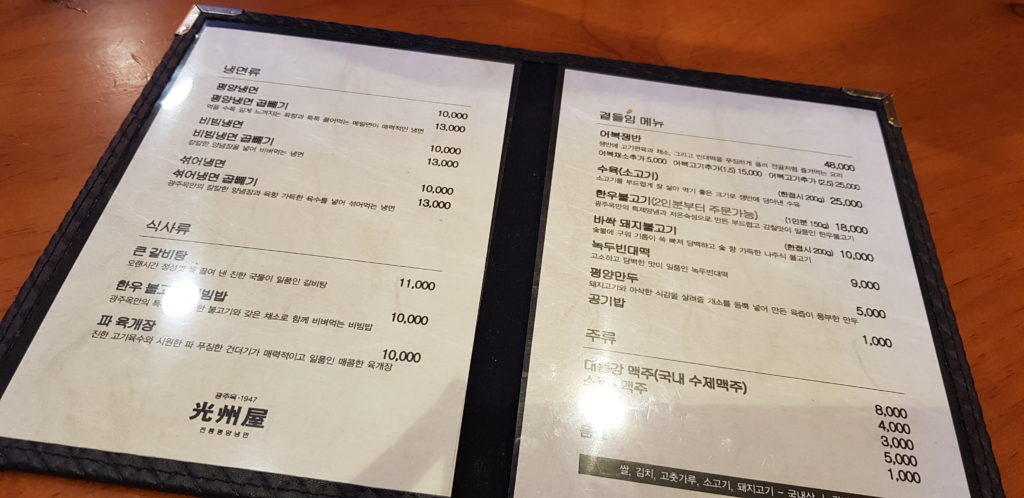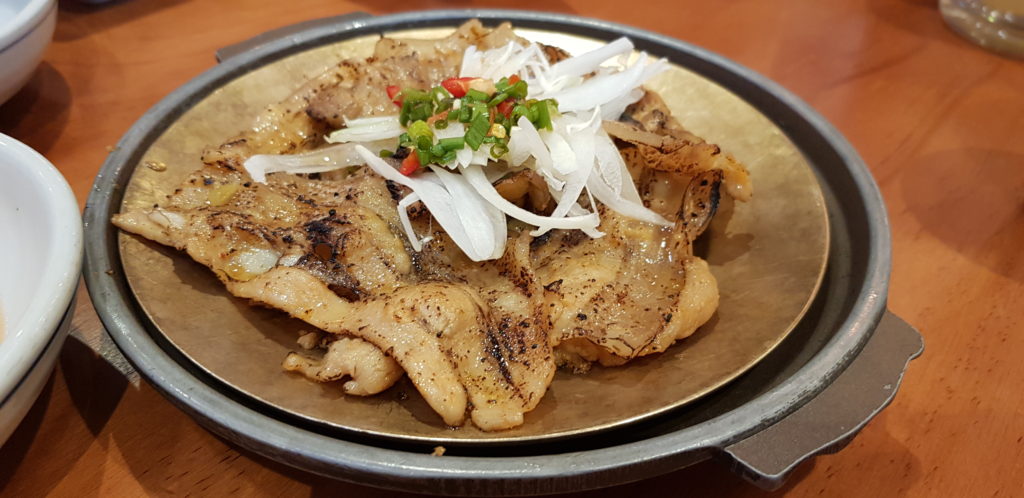Gwangju-ok 1947: Traditional Naengmyeon in a Modern Setting
Written and photographed by Karina Prananto.
One of the best things about living in Korea is its four seasons, as every season is so different and comes with unique culinary habits. Coming from a tropical country with only two seasons (dry and rainy, but with the same 32-degree-Celsius temperature), I can eat watermelon anytime I want, but in Korea, people will look at you strangely if you eat watermelon in winter, for example. Each season has been set with a certain food to consume, and summertime is synonomous with watermelons, ice cream, samgyetang, (삼계탕, chicken soup with ginseng) and of course, naengmyeon (냉면, cold noodles).
Now, originally, I was not a big fan of cold dishes. In my country, everything has to be served sizzling hot. You can find cold salads, but that is it. So in Korea, I first found it weird that people ate ice with their meals, like noodles. However, after having been living here for 13 years, naengmyeon has become a usual food for me to see in summer. Naengmyeon can be found anywhere now, but only a few places claim to be the best at serving the cold dish. One of them is Gwangju-ok.

Gwangju-ok boasts of having served naengmyeon since 1947, hence the name. It has two branches: The main one is located across from Nongseong Subway Station and the other is located near the Asia Culture Center. I am fortunate to live near their main branch, so I can go there easily. But to go along with the “tradition,” I only go there in summer.
If a restaurant is selling only naengmyeon, it does not usually sell well in wintertime. So Gwangju-ok offers not only naengmyeon but also hot dishes like galbi-tang (short rib soup) and bulgogi (sliced and seasoned barbequed beef). Still, their best dish is naengmyeon, but not just any naengmyeon: It is Pyeongyang naengmyeon. Pyeongyang naengmyeon is said to be one of the most famous dishes in North Korea, and if you are wondering how it tastes, you might want to visit this place.
Gwangju-ok claims to serve their naengmyeon in the traditional style (probably that means as it is in Pyeongyang). It is rather bland in comparison to other styles, but that is why all tables in Gwangju-ok are equipped with the essentials: mustard and vinegar to add more taste. After adding some of these, the taste kicks in. On every visit, we definitely order a bowl of naengmyeon, although they also sell bibim-naengmyeon (spicy buckwheat noodles). During our most recent visit, we ordered a plate of pork bulgogi and nokdu bindaetteok (녹두 빈대떡, green bean pancake). All orders arrived on our table within fifteen minutes.

Gwangju-ok sells their naengmyeon and bibim-naengmyeon in two sizes: regular and double. If you would like to order additional foods on the menu, a regular will be sufficient. Many may find it a bit tasteless, so unless you are sure you like the taste or just want to try it as is for the first time, I recommend ordering a regular size. We found the rest of the menu items to also be great. For example, the bindaetteok was crispy and the bulgogi was thinly sliced samgyeopsal (pork belly) that was grilled and tasted a bit like galbi.

Gwangju-ok is usually busy from 12 noon with break time lasting from 3:00 to 4:30 p.m. We went there once at 6:30 p.m. and found the place to be packed full, so on our last visit, we went at around 7:30 p.m., and we were able to find a seat. The restaurant is spacious and the service is very quick and efficient, so I am sure you will not have to wait for long. The restaurant also has only table seating, so do not worry about your legs getting cramps from sitting on the floor for too long. A small water kettle filled with chicken broth is also warm and refreshing, aside from the cold water also on offer. The restaurant is clean and has a modern feel to it compared to other naengmyeon restaurants I have visited in the past that had an old hanok (traditional Korean house) style. Instead, Gwangju-ok presents itself more as a Western-style restaurant. I find it very comfortable to be in.

So before summertime passes, make sure you visit Gwangju-ok and try a bowl of Pyeongyang naengmyeon. Bonus: They also have Pyeongyang mandu (dumplings). Wonder how it tastes? How about giving it a try? It can also be a new conversation piece with families and friends back home!
The Author
Karina Prananto is from Jakarta, Indonesia, and has been living in Gwangju since 2006. She loves Korean food – especially baekban (meal with a bowl of rice, soup, and many side dishes) and street foods – and loves how eating at Korean restaurants leaves her full, thanks to the abundant side dishes.





